It’s easy to get swept up in the media myths of the technology world. The good news is that a new generation readying themselves for careers in tech are looking past the stereotypes and embracing opportunity.
On Friday, LinkedIn hosted an event as part of its LinkedIn For Good initiative, in which it encouraged 2,500 employees around the world to spend the day giving back to their community.
As part of that “InDay” event, the company hosted 100 teenagers from the Boys and Girls Club of the Peninsula at its Mountain View, Calif. headquarters to talk about career opportunities, create a LinkedIn profile, and learn about the skills needed to achieve their dream jobs.
Breaking Down Media Myths About Silicon Valley
The event looked nothing like the Hollywood versions of the tech world we see in movies like The Internship and HBO’s Silicon Valley. While those shows satirize what it takes to make it in tech, they also risk celebrating and elevating the screen-friendly “brogrammer” cultural myth of hard-partying code jocks. While brogrammers are easier to find on TV than on the actual streets of San Francisco, the brogrammer stereotype has life because Silicon Valley does have a real problem attracting a diverse workforce.
Statistics recently released by major tech companies show that there are real numbers behind the stereotypes: The tech workforce is disproportionally Caucasian and male. (LinkedIn was one of the companies to share its numbers.)
Against this backdrop, it’s easy to understand why some get dispirited. But organizations and companies are working to change the culture of technology and nurture diverse voices, and women are fighting to change the culture of tech from within. And the teens we talked to weren’t paying much attention to Hollywood’s version of what a programmer looks like.
Teens In Tech
In a crowded room on the company’s leafy campus, LinkedIn employees and students from the Boys and Girls Club exchanged wisdom. Students discovered what it means to network, while employees reminisced about their own high-school days, and the angst and frustration of figuring out a career path.

After hearing from LinkedIn CEO Jeff Weiner and Peter Fortenbaugh, executive director of the Peninsula Boys and Girls Club, LinkedIn employees teamed up with students in one-on-one sessions to help build their online resumes, and, hopefully, put them en route to their future careers.
I shadowed three students who have dreams of working in tech to find out what drives them, and whether or not the culture of the tech community, often portrayed as toxic or excluding, now deters them from pursuing their future dreams.
All three were steadfast in their desire to become the next generation of builders. They weren’t worried about culture fit. They were more worried about mastering math.
“There’s no way [gender inequality] will be balanced by the time I’m coding.”
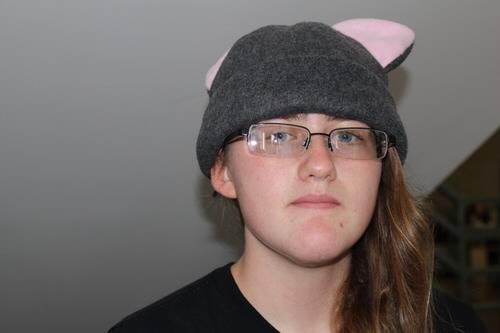
Dana Levinthal, 14, snacked on Lay’s potato chips and sipped on a raw-sugar Coca-Cola as she talked to me about wanting to become a programmer at Facebook or Google. What about a startup, I asked.
“There’s always a chance they could go under,” she replied. “I want something more secure.”
The sage teen from Redwood City doesn’t have any coding experience yet, though she’s heard of languages like Java and C++. But she thinks her experience in “modding” Minecraft, a popular game, has already taught her one of the most important skills about being a programmer: patience.
She does understand it takes more than creativity, patience and boundless energy to become a programmer; Dana wants to go to MIT, and is aiming to finish calculus by her senior year.
As a high-school freshman, she’s familiar with the imbalance of women in tech, but that only fuels her desire to be among the next generation of Googlers.
“I’m aware that only ten percent of women hold IT jobs,” she said. “There’s no way it will be balanced by the time I’m coding, in 10 to 15 years.”
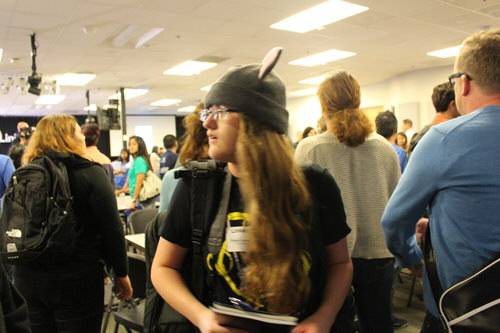
For some, the gender gap can be discouraging, especially since just 18 percent of computer science graduates in the U.S. are female, and reports of harassment and discrimination have cast shadows on the tech community. To Dana though, this imbalance presents an opportunity.
“Because women are a minority in that field, I’m more likely to get a scholarship and get hired,” she said.
“Don’t gain the world, and lose your soul.”
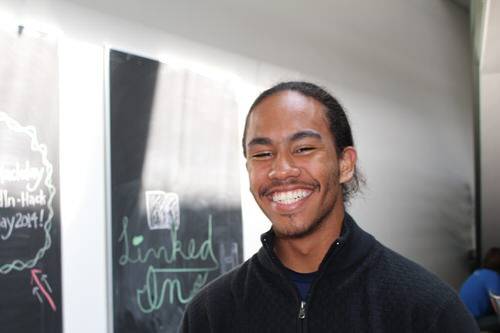
Diquan Richard’s idols are Steve Jobs and Bob Marley—two very different innovators whose passion and breakthroughs in creative and technical fields inspire him to pursue his career goal of becoming a Pixar animator. He’s been involved with the Boys and Girls Club for 14 years, and is a native of East Palo Alto.
He discovered his dream of working at Pixar in 7th grade, and he’s been perfecting his talent for drawing and storytelling while overcoming personal hardships ever since.
“Technology has given me comfort,” Diquan said. “It’s allowed me to connect with people during the most challenging times.”
Like most teenagers, 18-year-old Diquan uses applications like Snapchat and Instagram to connect with friends. On his Lenovo computer, he uses more sophisticated technology to build creatures with Photoshop, Flash and Maya, the animation software. Those will prove crucial to his burgeoning career.
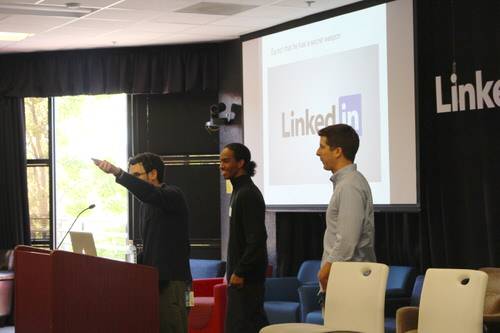
Diquan is a student at Cañada College, a two-year institution in Redwood City, Calif., where he’s taking general-education courses before applying to a university for a digital arts and animation degree.
“My biggest challenge in school is math,” he said. “It’s something I’m going to have to work with everyday—using geometry and algebra. Making sure everything cooperates.”
At the InDay event, LinkedIn employees helped Diquan take the first step to achieving his career. In a demonstration, two of them used Diquan’s profile as an example of how to connect with college alumni and ask for advice from people whose careers they admire. They discovered a Cañada College graduate who worked at Pixar, and the team offered to facilitate an introduction.
Diquan could not stop smiling.
Though technology will become an invaluable resource for him in the future, Diquan noted that it’s not all perfect. Some apps, he said, are a huge waste of time.
“Bob Marley once said, ‘Don’t gain the world, and lose your soul, wisdom is better than silver and gold,’” he told me.
“One stereotype I know about tech, is that they think guys are better.”
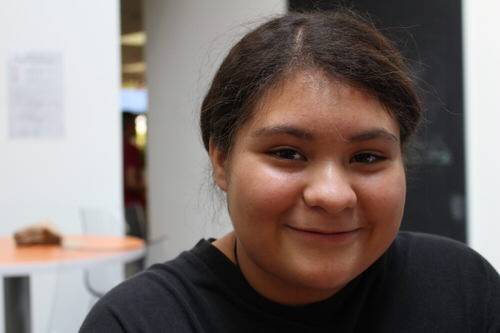
“I was kind of a weird child,” Anna Gomez, 14, said, as I sat down to ask her about her career plans. “One time I had cardboard boxes, and I would pretend they were metal and make a robot.”
“That’s not weird,” I told her. “That’s awesome.”
Anna wants to be a computer engineer and eventually a video game designer. Her favorite video game is Assassin’s Creed, which she plays regularly on her PlayStation 3.
She’s trying to learn coding, but she’s conflicted. Her high school offers computer engineering, but she also wants to take cooking as an elective. Anna hadn’t heard of organizations like Girls Who Code.
“Most of my friends are girls, and they don’t really play video games,” she said, and looked down at her hands. “Most of my guy friends play video games, though.”
Through the Boys and Girls Club, Anna has visited numerous tech companies, including Google, Intel, Facebook and LinkedIn. She says the experience has only encouraged her pursuit of working in technology, though she thinks it is very hard to get a job in tech.
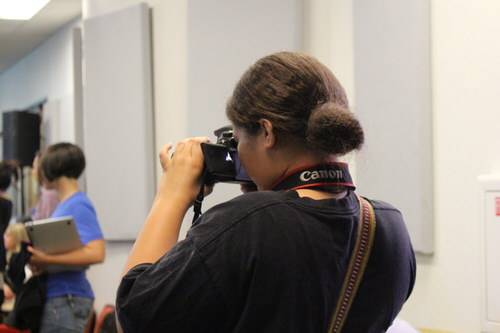
The biggest skill she thinks engineers need is, like the other students, math. Anna said math classes are going to be hard for her, but, with her brother as an influence, she’s going to learn coding, and eventually take computer science in college.
Like Dana, she’s not deterred by inequality or lack of women in engineering fields.
“One stereotype I know about tech, is that they think guys are better,” she said. “But I don’t think that’s true.”
A Promising Future
After setting up personal LinkedIn accounts and taking a handful of profile pictures, both silly and serious, the students made their way back to the crowded room, which was getting warmer by the minute.
A group of observers and participants trailed behind, as the girls took extra time photographing the LinkedIn campus with cameras provided by the Boys and Girls Club. They wanted to document everything.
By the afternoon’s end, Dana, Diquan, and Anna, along with many other club members, had their own LinkedIn profiles, which would help them discover career opportunities and connect with people just like them, in jobs they want to explore.
Back in the room, the students and mentors were asked to take a picture—and the smiling teens looked back at the camera promisingly.
The next generation of coders and makers don’t see the same frustration their counterparts working in tech right now face on a regular basis. Instead, they have hope that—although their path may not be perfect or easy—a passion for technology and education will get them started.
And once they’re inside those campuses they’ve visited as students, they’ll have the power to take on those challenges—and, eventually, change those stereotypes.
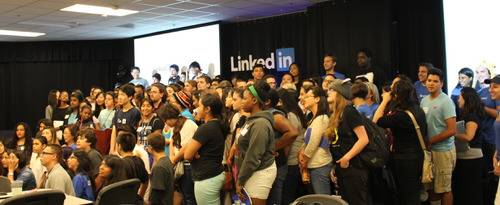
Photos by Selena Larson for ReadWrite










